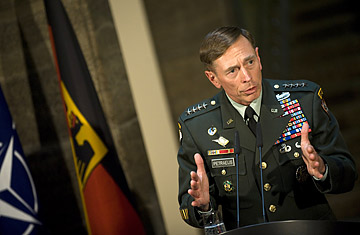
Correction Appended August 11, 2011
Back in June 2006, I wrote a column suggesting that counterinsurgency warfare was something that might work in Iraq, given that nothing else was. I even suggested that COIN — that dreadful, jingly acronym — was something Democrats might like, since it was an up-armored combination of community policing and social services. Almost immediately, I received a phone call from one David Petraeus, who said, "You're on the right track, but you don't know anything." Petraeus told me that he was out at Fort Leavenworth, running the Army's equivalent of a think tank and university. "You want to come out here and learn more?"
So I went. But before I left, a reading list — a rather long reading list — arrived. I read the least taxing stuff but soon learned that it wasn't nearly enough: if you wanted to hang with Petraeus, you had to read it all. Indeed, the week I spent at Fort Leavenworth was the most rigorous intellectual experience of my career in journalism. Petraeus had surrounded himself with top-of-the-class West Point grads and Rhodes scholars. They were in the midst of a huge project: writing a counterinsurgency doctrine and changing the way American soldiers were trained to fight in the 21st century. They were open and generous with their time — I remember a long evening of Petraeus and Company fielding my rudimentary questions at a Mexican restaurant. (The general allowed himself one margarita.)
In a few weeks, David Petraeus will retire from the Army to take over the CIA. His achievements will be lauded, and debated, for as long as nations field armed forces. Already, a passionate debate has broken out in military circles about what, if anything, he accomplished in Iraq and Afghanistan. The jury is still out on that, although his Iraq battle plan clearly quieted that country down, for a time, and allowed our troops to leave safely and with honor. In Afghanistan, the deaths of 38 U.S. and Afghan troops, including 22 Navy SEALs, in the Chinook helicopter shot down by the Taliban in Wardak province — just beyond the suburbs of Kabul — is a reminder of how tenuous progress has been.
In truth, the general's most important legacy may lie in the role he has played in transforming the Army from a blunt instrument, designed to fight tank battles on the plains of Europe, into a "learning institution" that trains its troops for the flexibility and creativity necessary to fight guerrilla wars in the information age.
A few weeks ago, I visited Petraeus at his temporary home at Fort Myer, just across the Potomac from Washington, and the first thing he did was show me his favorite painting: a Frederic Remington called The Stampede. "This is not a nice, orderly cattle drive," he said. "There's all sorts of stuff going on. The cowboys are straining to keep up, to restore control. And that's the most important quality that our troopers need going into asymmetrical combat situations: they've got to be comfortable in the chaos."
Petraeus told me about visiting the artillery school at Fort Sill, Okla., early in his tenure. "They had this remarkable simulator there," he said, describing a video-game-like device that enabled artillery officers to respond to the sort of threats they might face in Iraq. They showed Petraeus a scenario in which American troops were trapped in a building by insurgents firing rocket-propelled grenades from several armed pickup trucks. In the scenario, the U.S. captain called in mortar fire, which destroyed the vehicles. "I said, 'Wait a minute. We don't shoot mortars in Baghdad. They're too inaccurate. By using this scenario, you're putting our troops at terrible risk in the field.'" After his visit, the general told me, they shut down the school, quickly retooled the course and reopened with a curriculum that reflected the realities of war in Iraq.
Petraeus was acting on what he calls a "really big idea": full-spectrum warfare, which added COIN to the mix of traditional offensive and defensive operations. At Fort Leavenworth, home to a required one-year graduate-school program for majors, Petraeus added courses in COIN and Islamic culture, plus a Pashtu- or Arabic-language elective, to the traditional curriculum in strategy, tactics and logistics. "We did that throughout the Army," Petraeus says. "Every soldier gets that now."
War is ghastly under the best of circumstances. The so-called war on terror has been a dubious proposition from the start. But for those of us who have seen American forces operating in combat and counterinsurgency situations downrange, there is no doubt that this is a vastly different Army than it was 10 years ago — it's smarter, sleeker, more flexible and creative. That force is David Petraeus' greatest achievement, and the heart of his historic service to our country.
To read Joe's blog posts, go to time.com/swampland
The original version of this article stated that the number of Navy SEALs killed in Afghanistan when the Chinook helicopter was shot down by the Taliban was 22. On Tuesday, the Pentagon corrected that number to 17.
